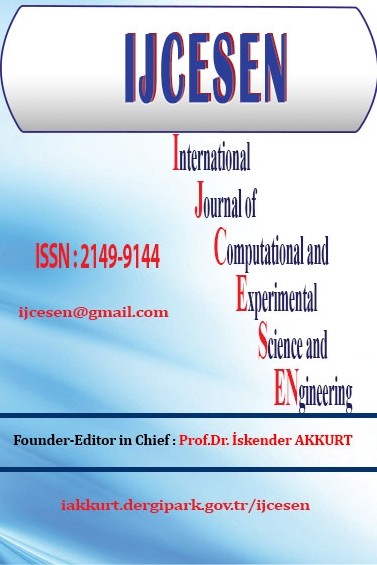Dynamic and quantitative Sensitivity analysis on the efficient development of tight oil
Dynamic and quantitative Sensitivity analysis on the efficient development of tight oil
___
- Bai, B., Salehi, S., Nygaard, R., & Aladasani, A. (2014, February 25). Optimizing the Development of Tight Oil Formations. Society of Petroleum Engineers.SPE-167742-MS. http://dx.doi.org/10.2118/167742-MS
- Boczar T, Franz P. The Application of the Correlative Analysis and the Regression Function for Determining Correlations of the Measurement Results of Acoustic Emission Generated by Partial Discharges[J]. Acta Physica Polonica A, 2009, 116:281_284.http:/dx.doi.org/10.12693/APhysPolA.116.281
- Baig, M. T., Alnuaim, S., & Rammay, M. H. (2015, June 4). Productivity Increase Estimation for Multi Stage Fracturing in Horizontal Wells for Tight Oil Reservoirs. Society of Petroleum Engineers. SPE-178030-MS. http://dx.doi.org/10.2118/178030-MS
- Baoquan, Z., Linsong, C., & Fei, H. (2010, January 1). Experiment and Mechanism Analysis on Threshold Pressure Gradient with Different Fluids. Society of Petroleum Engineers. SPE-140678-MS. http://dx.doi.org/10.2118/140678-MS
- Chen, H.-Y., & Teufel, L. W. (2001, January 1). Understanding the Effects of Reservoir and Operating Parameters on Tight-Gas Production Decline. Society of Petroleum Engineers. SPE-71066-MS. http://dx.doi.org/10.2118/71066-MS
- CMG. IMEX User’s Guide, Computer Modeling Group Ltd, 2012.
- Cui, Q., & Abass, H.H. (2016, May 5). Experimental Study of Permeability Decline in Tight Formations During Long-Term Depletion. Society of Petroleum Engineers.SPE-180257-MS. http://dx.doi.org/10.2118/180257-MS
- Experimental design and Design-Expert, SPSS applications.
- Lei, Q., Xiong, W., Yuang, J., Cui, Y., & Wu, Y.-S. (2007, January 1). Analysis of Stress Sensitivity and Its Influence on Oil Production From Tight Reservoirs. Society of Petroleum Engineers. SPE-111148-MS. http://dx.doi.org/10.2118/111148-MS
- Li, X., Wei, H., Chen, B., Liu, X., Wang, W., & Zhao, X. (2008, January 1). Multi-Stage Fracturing Stimulations Improve Well Performance in Tight Oil Reservoirs of the Chang qing Oilfield. International Petroleum Technology Conference. IPTC-12303-MS. http://dx.doi.org/10.2523/IPTC-12303-MS
- Lin, M., Chen, S., Ding, W., Chen, Z. (John), & Xu, J. (2015, May 1). Effect of Fracture Geometry on Well Production in Hydraulic-Fractured Tight Oil Reservoirs. Society of Petroleum Engineers. SPE-167761-PA. http://dx.doi.org/10.2118/167761-PA
- Roussel, N. P., & Sharma, M. M. (2010, January 1). Optimizing Fracture Spacing and Sequencing in Horizontal Well Fracturing. Society of Petroleum Engineers.SPE-127986-MS. http://dx.doi.org/10.2118/127986-MS
- Sigal, R. F. (2002, March 1). The Pressure Dependence Of Permeability. Society of Petrophysicists and Well-Log Analysts.
- Thomas, L. K., Katz, D. L., & Tek, M. R. (1968, June 1). Threshold Pressure Phenomena in Porous Media. Society of Petroleum Engineers. SPE-1816-PA. http://dx.doi.org/10.2118/1816-PA
- Wei, Y., et al., Determination of dynamic reserves of fractured-horizontal wells in tight oil reservoirs by multi-region material balance method. Petroleum Exploration & Development, 2016. http://dx.doi.org/10.1016/S1876-3804(16)30057-X
- Benyahia F, Nacer A, Moulai H, et al. Discharge Currents Discrimination Technique Based on Multi-Linear Regression Line and Artificial Neural Networks for Power Transformers Diagnosis[J]. Acta Physica Polonica A, 2013, 123(2): 250-253.http://dx.doi.org/10.12693/APhysPolA.123.250
- Haranczyk H, Wojcik A. Liquid Phase Contained in Porous Rock as Observed by Proton Magnetic Relaxation[J]. Acta Physica Polonica A, 2000: 153-161. DOI:10.12693/APhysPolA.98.153
- Yayın Aralığı: 4
- Başlangıç: 2015
- Yayıncı: Prof.Dr. İskender Akkurt
Dynamic and quantitative Sensitivity analysis on the efficient development of tight oil
Jie BAİ, Huiqing LİU, Jing WANG, Ling XİE, Xueping Lİ
Petrographical and Sedimentological Study of Balambo Formation at Northeastern Iraq
AMMAR ALGBURİ, Enis Kemal SAGULAR
A Fuzzy Hybrid Decision Model for Renewable Energy Sources Selection
Merve CENGİZ TOKLU, Harun TAŞKIN
Onur AYAN, Duygu Zeynep DEMİREZ, Huseyin Kagan KİZİLOZ, Gizem INCİ, Seckin ISLEYEN, Semih ERGİN
